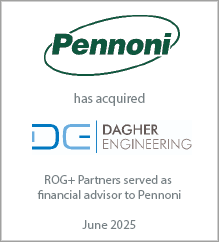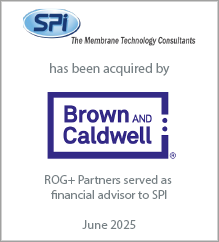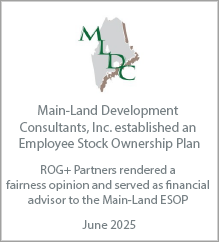Steve Gido specializes in corporate financial advisory services with a focus on mergers and acquisitions. Steve has assisted architecture, engineering, environmental consulting and construction firms of all sizes across North America achieve their growth or liquidity goals through successful mergers & acquisitions. Steve has over 15 years of investment banking experience and holds the chartered financial analyst (CFA) designation from the CFA Institute.
The Dilemmas of A/E Family Ownership
March 22, 2015
Over the past several years, we have witnessed an increased demand for ownership transition and M&A consulting for family-owned A/E and environmental consulting firms. These inquiries have cut across the gamut of family ties – husband/wife, siblings, and parent/child owned organizations. They have also come to us across a range of firm size, disciplines, and geographic locations.
When many think of family-run businesses associated with our industry, it’s traditionally been with our friends at general contractor firms (think of how many companies end with “& Sons” or “Brothers” as it relates to family construction dynasties). Most A/E firms are not family owned and have disparate individual backgrounds in terms of professional ownership, management, and overall day-to-day operations.
We think the severe design recession changed this to some degree. Hungry entrepreneurs itching for their own business as well as numerous displaced A/E professionals reluctantly started their own small boutiques. These individuals often initiate the business out of their home and may even tap into the assistance of a spouse to “do the books”, create a website, or utilize family savings and credit cards for seed capital. In addition, as building and infrastructure demand waned starting in 2007, some shrewd firms brought a licensed spouse to the ownership fold as a 51% WBE (woman business enterprise) or other similar maneuvers to attract new clients and project types.
Maybe we shouldn’t be surprised after all. Family businesses are “the most common type of business on the earth, particularly in developing countries,” says Professor Wesley Sine, faculty director of the Cornell University Johnson Graduate School of Management’s Entrepreneurship and Innovation Institute. In addition, The Family Firm Institute (FFI), a nonprofit, has reported that family firms create an estimated 70 to 90 % of global GDP annually as well as 50 to 80% of jobs in the majority of countries worldwide. Many owners and entrepreneurs start out with financial and emotional support from family; in fact, the FFI reports that a whopping 85% of startups are established with family money!
Many family-owned A/E firms have wonderful characteristics. They can often possess a close “paternal/ maternal” company culture where treating and protecting employees just like family members guides their decision making and interactions. These organizations can be slow to fire dedicated team members purely for bottom line results and oftentimes have a “we’re all in this together” family mentality when times are good or bad for organizational resiliency. As a result, family-run A/E organizations may exhibit higher employee loyalty and retention rates and their staff may cultivate a deeper commitment to the firm’s mission and values.
However, we can all admit family dynamics and relationships can be complicated. Issues such as rivalries, resentment, drama, jealousy and entitlement can be found among relatives in professional organizations. And in the context of family businesses and pursuing sound ownership transition, these problems can frequently be exacerbated. Below are four typical challenges we find with family-owned A/E firms:
Is your A/E firm feeling a bit like “All in the Family” in terms of organizational and transition challenges and achieving your long-term goals? Let us know. ROG+ Partners brings years of seasoned financial and business experience in navigating A/E and environmental clients of all backgrounds through strategic and ownership alternatives in an ever changing landscape.
When many think of family-run businesses associated with our industry, it’s traditionally been with our friends at general contractor firms (think of how many companies end with “& Sons” or “Brothers” as it relates to family construction dynasties). Most A/E firms are not family owned and have disparate individual backgrounds in terms of professional ownership, management, and overall day-to-day operations.
We think the severe design recession changed this to some degree. Hungry entrepreneurs itching for their own business as well as numerous displaced A/E professionals reluctantly started their own small boutiques. These individuals often initiate the business out of their home and may even tap into the assistance of a spouse to “do the books”, create a website, or utilize family savings and credit cards for seed capital. In addition, as building and infrastructure demand waned starting in 2007, some shrewd firms brought a licensed spouse to the ownership fold as a 51% WBE (woman business enterprise) or other similar maneuvers to attract new clients and project types.
Maybe we shouldn’t be surprised after all. Family businesses are “the most common type of business on the earth, particularly in developing countries,” says Professor Wesley Sine, faculty director of the Cornell University Johnson Graduate School of Management’s Entrepreneurship and Innovation Institute. In addition, The Family Firm Institute (FFI), a nonprofit, has reported that family firms create an estimated 70 to 90 % of global GDP annually as well as 50 to 80% of jobs in the majority of countries worldwide. Many owners and entrepreneurs start out with financial and emotional support from family; in fact, the FFI reports that a whopping 85% of startups are established with family money!
Many family-owned A/E firms have wonderful characteristics. They can often possess a close “paternal/ maternal” company culture where treating and protecting employees just like family members guides their decision making and interactions. These organizations can be slow to fire dedicated team members purely for bottom line results and oftentimes have a “we’re all in this together” family mentality when times are good or bad for organizational resiliency. As a result, family-run A/E organizations may exhibit higher employee loyalty and retention rates and their staff may cultivate a deeper commitment to the firm’s mission and values.
However, we can all admit family dynamics and relationships can be complicated. Issues such as rivalries, resentment, drama, jealousy and entitlement can be found among relatives in professional organizations. And in the context of family businesses and pursuing sound ownership transition, these problems can frequently be exacerbated. Below are four typical challenges we find with family-owned A/E firms:
- Which takes strategic priority – business or family pursuits? The most confounding aspect of family-owned firms can be what exactly is its strategic mission or purpose. Many owners will tell you it’s to offer exemplary engineering, architecture or scientific services, making communities and society better, and serving its clients and staff just like their non-family competitors. But it candidly may also serve first and foremost as a vehicle for family wealth, children or sibling employment, or closely-held decisions and control. Should profits be reinvested in the A/E firm for growth or is it fair to extract those for other family pursuits, like ancillary business ventures or real estate investments? Employees can grow confused and resentful in the presence of non-productive family members’ excessive vacations and perquisites, and personal squabbles that spill over into business matters.
- Ownership may not be available to “outsiders” – The Godfather movies were a classic case study in tight organizational kinship and control. Members and associates who were not “blood” and part of the family lineage could never be fully welcomed into the Corleone Empire. This is indeed the case with many family A/E firms we have encountered. Oftentimes, A/E family ownership is quite complicated, commingled with estate and tax planning goals designed to protect the “nest egg” for inheritance purposes. Some fear that opening the books to new employee-owners is a slippery slope to entangling insiders and outsiders, between those who are loyal and those who eventually may not be. As such, it is common to see A/E firms offer other means of retention and recruitment models other than direct equity ownership, such as higher salaries and bonuses, non-voting classes of stock, and phantom stock, stock options, or synthetic equity programs in order to have a participatory upside to overall company performance.
- Leadership succession can be thorny – Making the leap from a first generation owned and led firm to the next one is a struggle for A/E firms of all shapes and sizes. The firm’s ethos and culture is often part of the founder’s “cult of persona”, whether a family-run firm or not. In many family organizations it is clear, and even unspoken, that the founder’s son or daughter will be next in line to take over the business. But what if that possibility isn’t there or, worse, the organization’s staff knows that “junior” doesn’t have the skills or acumen to be in charge? Should a new insider be elevated or an external candidate found to be the next CEO? Can that person effectively juggle the dichotomy of “family business” vs. “design business”?
- They can be difficult to sell – If a harmonious internal succession plan to other family members isn’t available, these firms may attempt to test the waters and sell to an outside buyer. We have experience and anecdotes in taking husband/wife, co-sibling, and parent/child ownership teams out to market. Surprisingly, in cases where the strategic, synergistic and valuation expectations are aligned between buyer and seller, family relationships and governance are often minor worries, and a transaction can be consummated. In other cases, strategic buyers from the start are simply leery of stepping into a family-run A/E firm. Larger firms may have “nepotism” rules that prevent direct family member reporting relationships. In other cases cultural and communication differences as well as integrating family members into new organizational roles may be too difficult to overcome.
Is your A/E firm feeling a bit like “All in the Family” in terms of organizational and transition challenges and achieving your long-term goals? Let us know. ROG+ Partners brings years of seasoned financial and business experience in navigating A/E and environmental clients of all backgrounds through strategic and ownership alternatives in an ever changing landscape.








